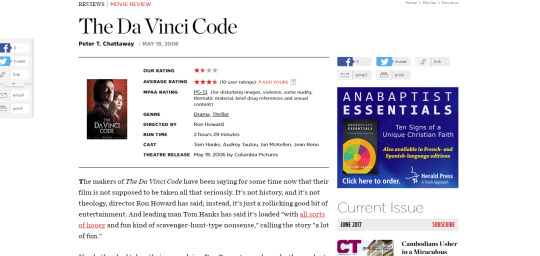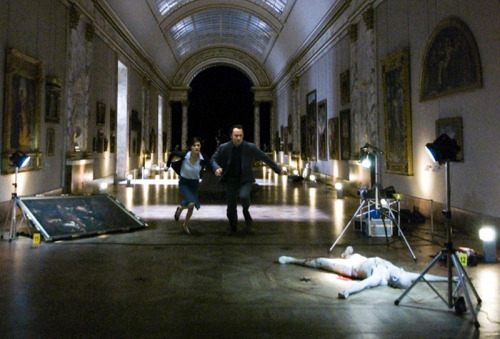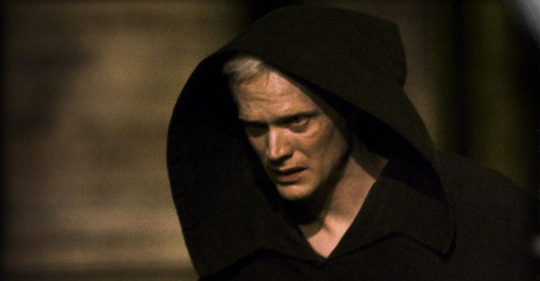Don't wanna be here? Send us removal request.
Text
Editorial Cartoon

This editorial cartoon implies the historical inaccuracies put in place throughout the novel and film. Both medias have been under the criticism of the church as well as critics around the world for their imprecision.
0 notes
Text
Criticism Towards The Da Vinci Code
The following article outlines the criticism the film and novel for The Da Vinci Code faced after its publication in 2003 as well as 2006 release in theatres.

Find the article here.
Most of these criticisms were directed towards the book’s inaccurate descriptions of European art, history, architecture, and geography. I, however, don’t understand what the big fuss is about considering that the author, in the opening pages of the book, claims that, aside from the modern characters, the book is completely factual.
One of the main arguments is the lack of research employed by Dan Brown for his several geographical mistakes. One of these mistakes being the book’s storyline in which the albino monk named Silas, was arrested in France, imprisoned in Andorra and escaped to Spain. This error supposedly demonstrates the lack of basic research that would could have been avoided from a quick glance at a map or tourist guide as it is improbable that someone arrested along the French coast would be imprisoned in another country.
It is also notable that albinos typically have very poor vision; in fact to the point where many are legally blind. It is therefore highly unlikely that the albino Silas could ever become an expert marksman, or even that he could drive.
The article goes into further detail on how the book and film lack the thorough research that should’ve have been conducted upon creation in order to even try to conceptualize the idea of Gnosticism - fictional or not. It especially talks about the inaccurate perspective utilized when discussing Christianity.
1 note
·
View note
Text
Technical Aspects Behind the Da Vinci Code Film
The Da Vinci code is a critically acclaimed 2006 American mystery horror thriller film directed by Ron Howard. The film, as much as the book, is considered very controversial especially by the Roman Catholic Church. This riveting storyline entices audiences with every choice in sound, lighting, and camera angle. The author Dan Brown’s work The Da Vinci Code (2003) is brought to life by the essential work of the director.
Throughout the film, the world’s grandest museum, the Louvre - located in France, is often depicted in all it’s glory. Here there are several rooms that follow any period from ancient to modern, containing various national heritage items and perhaps the national heritage of several other countries. Cough cough. Stolen artwork. The director and film crew were fortunately granted permission to film by the Louvre. They clearly used this opportunity to its full advantage; making for some of the most memorable scenes at this magnificent location.

In one particular scene at the beginning, the protagonist Robert Langdon (Tom Hanks) is taken by French police to the Louvre, where Jacques Saunière’s dead body has been discovered. After some research, it appears that David White of Altered States FX, a prosthetics and special makeup effects company, was tasked with creating a naked photo-realistic silicone body for the scene. Lighting effects were utilized to conceal the body’s genitalia. This scene was planned with such utmost precision, it’s nearly impossible to look away.

Finally, the soundtrack created for the film is a fresh and wonderfully effective soundscape that involves an intense orchestra, creating much of that ‘stained glass cathedral’ feeling. At the final scene of the movie in which the answer about the Rose Line suddenly dawns upon Langdon, the background composition renders many powerful emotions. It’s no wonder that the music was nominated in 2007 for a Golden Globe Award for Best Original Score.
Robert Langdon then kneels and says “She rests at last beneath the starry skies.” The camera smoothly goes through the glass floor through the small pyramid to hover upon the sarcophagus. The light falls on the dust in the air giving a mystical aura to the sarcophagus and the withered rose beside it. The camera zooms out from the underground vault and focuses on Langdon. This specific direction is vital and critical for the movie to have been as successful as it was, it is evident that every shadow and harmony was precisely employed to create the effect intended and bring the story to life.
Watch the final scene here.
0 notes
Text
The Da Vinci Code Scenes In The Book Versus Movie (Hey! That Wasn’t In The Book!)
There is much variance between scenes in the phenomenal the Da Vinci Code book and film. In fact, I was actually able to find five key differences between events that occurred in either. Although, it is completely understandable as to why a director might have to change small scenes throughout the plot (especially considering how limited the director was with all the comments and obstacles put in place by the Church) some of the changes are quite noticeable.
One of the first things I noticed was that the movie depicts Remy indicating and implying that he is the teacher, while in the novel Remy tells Silas directly that he works for the teacher. This is a minor difference, but it was apparent.

The second thing I noticed was that in the novel, Fache suspects Langdon is responsible for Sauniere's death because his name was written on the floor. In the film, he is told by Aringarosa that he overheard Langdon confess to the murder.
Thirdly, in the book Robert and Sophie find a message on Newton's tomb, that Teabing is in College Hall, a nearby building. There they find Teabing. In the movie, Teabing doesn't leave a note, and rather he forces them into the hall at gunpoint.
The fourth thing I noticed and perhaps most undeniable was that in the book, there are two cryptextes: they open the first one on Teabing's plane with the word “SOFIA” (referring to Sophie's given name and an ancient word for intelligence). After that, they find a smaller cryptex in it which they open with the word “APPLE”. In the movie, it is solely the one cryptex which they open with the word “APPLE”.
Last but not least is by far one of the most pivotal scene differences. In the end of the book, Silas shoots Aringarosa by mistake and then carries him all the way to hospital before he dies. In the end of the film, it is Silas who initially gets shot by the police and dies soon after having shot Aringarosa by mistake.
One quote that was the same in both the movie and novel was,
“So dark the con of man.” ― Dan Brown, The Da Vinci Code This is an anagram for "Madonna of the Rocks" the name of two famous identical paintings created by Leonardo Da Vinci.
These differences are minor, but still play an essential role in the build up pf the storyline and the enticement of audiences/readers.
0 notes
Text
Actors and Setting in The Da Vinci Code Film Versus Novel
The actors and setting in the film of The Da Vinci Code help develop my knowledge of the characters and setting in the book because every line and distinguishable emotion an actor/actress projects further amplifies my understanding of how the characters were meant to be.
In the film, Robert Langdon says, “Okay, maybe there is no proof. Maybe the Grail is lost forever. But, Sophie, the only thing that matters is what you believe. History shows us Jesus was an extraordinary man, a human inspiration. That's it. That's all the evidence has ever proved. But... when I was a boy... when I was down in that well Teabing told you about, I thought I was going to die, Sophie. What I did, I prayed. I prayed to Jesus to keep me alive so I could see my parents again, so I could go to school again, so I could play with my dog. Sometimes I wonder if I wasn't alone down there. Why does it have to be human or divine? Maybe human is divine. Why couldn't Jesus have been a father and still be capable of all those miracles?”
This quotes portrays the more spiritual side of Langdon, rather than the secular version that we often see in the book.
In the book, Langdon says “Widespread acceptance of an idea is not proof of its validity.” Automatically when I read those lines, I carried a more temporal view of him, but when he says those words in the film, I realized that he does indeed have a more theological perspective on life.
When Silas is dying the film, he shouts out, “Soy phantasma!” This quote not only emphasizes the Latin-attached side of him, but also the part bizarre side of him, of which he believes to be inhuman - a ghost.

In the book, there is a nostalgic flashback from Sophie’s point of view.
“Sophie still didn't like the painting. "She looks like she knows something … like when kids at school have a secret."
Her grandfather laughed. "That's part of why she is so famous. People like to guess why she is smiling."
"Do you know why she's smiling?"
"Maybe." Her grandfather winked. "Someday I'll tell you all about it."
Sophie stamped her foot. "I told you I don't like secrets!"
"Princess," he smiled. "Life is filled with secrets. You can't learn them all at once." (21.33-38)
This scene stresses the underlying matter of secrets and reminiscence throughout the novel, and is even carried well into the film, for instance when Sophie mentions, “It's a cryptex. Da Vinci's design. Saunière made me one for my birthday once.”
The movie constantly portrays the eerie darkness I came to know and love throughout the book. I feel it accurately depicts the scenes in the way the author, Dan Brown, desired them to look. The entire movie and book carry the theme of suspense to an extent in which the audience is always intrigued, awaiting what’s to come.
0 notes
Text
The Theme Of The Subjectivity of History In The Film The Da Vinci Code
The theme of subjectivity of history is constantly exemplified in the novel as well as the book The Da Vinci Code.
The Da Vinci Code constantly raises the question of whether history books necessarily tell the only truth. The novel and movie are full of reinterpretations of commonly told stories, such as those of Jesus’ life, the pentacle, and the Da Vinci fresco The Last Supper.
In the film the following scene incurs between Langdon and Sophie:
Sophie Neveu: Maybe there is something about this Priory of Sion.
Robert Langdon: I hope not. Any Priory story ends in bloodshed. They were butchered by the Church. It all started over a thousand years ago when a French king conquered the holy city of Jerusalem. This crusade, one of the most massive and sweeping in history was actually orchestrated by a secret brotherhood: the Priory of Sion and their military arm, the Knights Templar.
Sophie Neveu: But the Templars were created to protect the Holy Land. Robert Langdon: That was a cover to hide their true goal, according to this myth. Supposedly the invasion was to find an artefact lost since the time of Christ. An artifact, it was said, the Church would kill to possess.
Sophie Neveu: Did they find it, this buried treasure?
Robert Langdon: Put it this way: One day the Templars simply stopped searching. They quit the Holy Land and traveled directly to Rome. Whether they blackmailed the papacy or the Church bought their silence, no one knows. But it is a fact the papacy declared these Priory knights, these Knights Templar, of limitless power. By the 1300s, the Templars had grown too powerful. Too threatening. So the Vatican issued secret orders to be opened simultaneously all across Europe. The Pope had declared the Knights Templar Satan worshipers and said God had charged him with cleansing the earth of these heretics. The plan went off like clockwork. The Templars were all but exterminated. The date was October 13th, 1307. A Friday.
Sophie Neveu: Friday the 13th...
Robert Langdon: The Pope sent troops to claim the Priory's treasure but they found nothing. The few surviving Knights of the Priory had vanished and the search for their sacred artifact began again.
Sophie Neveu: What artifact? I've never heard about any of this.
Robert Langdon: Yes, you have. Almost everyone on earth has. You just know it as the Holy Grail.
This conversation further proves the theme of subjectivity of history even at one point in the novel Langdon says that perhaps the secrets of the Grail should be preserved in order to allow people to keep their faith. He also thinks that people who truly believe in God will be able to accept the idea that the Bible is full of metaphors, not literal transcripts of the truth. People’s faith, in other words, can withstand the truth. In the book and film, it is persistently reiterated that even the Bible was compiled in a way that exempts the missing gospels. Langdon even interprets the Disney movie The Little Mermaid, recasting it as an attempt by Disney to show that the divine femininity that has been lost. All of these retellings are presented as at least partly true.
0 notes